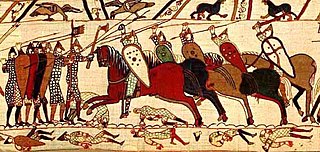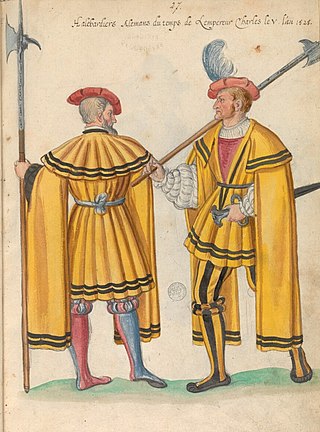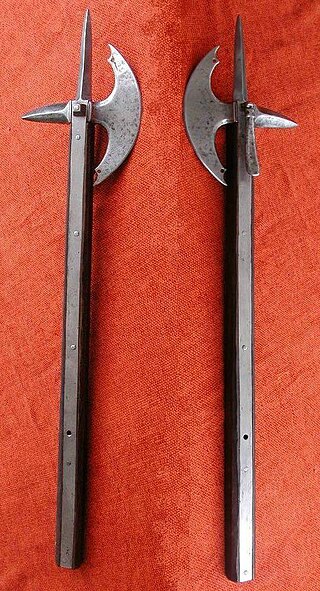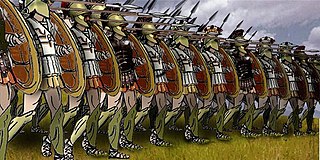
A polearm or pole weapon is a close combat weapon in which the main fighting part of the weapon is fitted to the end of a long shaft, typically of wood, extending the user's effective range and striking power. Polearms are predominantly melee weapons, with a subclass of spear-like designs fit for thrusting and/or throwing. Because many polearms were adapted from agricultural implements or other fairly abundant tools, and contained relatively little metal, they were cheap to make and readily available. When belligerents in warfare had a poorer class who could not pay for dedicated military weapons, they would often appropriate tools as cheap weapons. The cost of training was comparatively low, since these conscripted farmers had spent most of their lives using these "weapons" in the fields. This made polearms the favoured weapon of peasant levies and peasant rebellions the world over.
A spear is a polearm consisting of a shaft, usually of wood, with a pointed head. The head may be simply the sharpened end of the shaft itself, as is the case with fire hardened spears, or it may be made of a more durable material fastened to the shaft, such as bone, flint, obsidian, copper, bronze, iron, or steel. The most common design for hunting and/or warfare, since ancient times has incorporated a metal spearhead shaped like a triangle, diamond, or leaf. The heads of fishing spears usually feature multiple sharp points, with or without barbs.

A lance is a long thrusting spear designed to be used by a mounted warrior or cavalry soldier (lancer). In ancient and medieval warfare, it evolved into the leading weapon in cavalry charges, and was unsuited for throwing or for repeated thrusting, unlike similar weapons of the javelin and pike family typically used by infantry. Lances were often equipped with a vamplate, a small circular plate to prevent the hand sliding up the shaft upon impact, and beginning in the late 14th century, they were used in conjunction with a lance rest attached to the breastplate. Though best known as a military and sporting weapon carried by European knights and men-at-arms, the use of lances was widespread throughout Eastern Asia, the Middle East, and Northern Africa wherever suitable mounts were available. Lancers of the medieval period also carried secondary weapons such as swords, battle axes, war hammers, maces and daggers for use in hand-to-hand combat, since the lance was often a one-use-per-engagement weapon; assuming the lance survived the initial impact without breaking, it was often too long, heavy, and slow to be effective against opponents in a melee.

A halberd is a two-handed polearm that came to prominent use from the 13th to 16th centuries. The halberd consists of an axe blade topped with a spike mounted on a long shaft. It can have a hook or thorn on the back side of the axe blade for grappling mounted combatants. The halberd was usually 1.5 to 1.8 metres long.

A bayonet is a knife, dagger, sword, or spike-shaped weapon designed to fit on the end of the muzzle of a rifle, carbine, musket or similar firearm, allowing it to be used as a spear-like weapon. The term is traditionally derived from Bayonne, the town in south-west France where bayonets were supposedly first used by Basques in the 17th century. From the early 17th to the early 20th century, it was a melee weapon used by infantry for offensive and/or defensive tactics. Today, it is considered an ancillary weapon or weapon of last resort, although it is still used for ceremonial purposes.

A pike is a long thrusting spear formerly used in European warfare from the Late Middle Ages and most of the early modern period, and wielded by foot soldiers deployed in pike square formation, until it was largely replaced by bayonet-equipped muskets. The pike was particularly well known as the primary weapon of Swiss mercenary, German Landsknecht units and French sans-culottes. A similar weapon, the sarissa, had been used in antiquity by Alexander the Great's Macedonian phalanx infantry.

Cuirassiers were cavalry equipped with a cuirass, sword, and pistols. Cuirassiers first appeared in mid-to-late 16th century Europe as a result of armoured cavalry, such as men-at-arms and demi-lancers discarding their lances and adopting pistols as their primary weapon. In the later part of the 17th century, the cuirassier lost his limb armour and subsequently wore only the cuirass, and sometimes a helmet. By this time, the sword or sabre had become his primary weapon, with pistols relegated to a secondary function.

"Other ranks" is the term used to refer to all ranks below officers in the British Army and the Royal Marines. It includes warrant officers, non-commissioned officers ("NCOs") and ordinary soldiers with the rank of private or regimental equivalent. Officers may, in speaking, distinguish themselves from those "in the ranks".

A partisan is a type of polearm that was used in Europe during the 16th, 17th, and 18th centuries. It consisted of a spearhead mounted on a long wooden shaft, with protrusions on the sides which aided in parrying sword thrusts. The partisan was often used by infantry soldiers, who would use the weapon to fend off cavalry charges. The protrusions on the sides of the spearhead were also useful for catching and trapping an opponent's sword, allowing the user to disarm them. In profile, the head of a partisan may look similar to other types of polearm, such as the halberd, pike, ranseur, spontoon, ox tongue, or spetum.

A battle axe is an axe specifically designed for combat. Battle axes were specialized versions of utility axes. Many were suitable for use in one hand, while others were larger and were deployed two-handed.

For much of history, humans have used some form of cavalry for war and, as a result, cavalry tactics have evolved over time. Tactically, the main advantages of cavalry over infantry were greater mobility, a larger impact, and a higher riding position.

Pike and shot was a historical infantry tactical formation that first appeared during the late 15th and early 16th centuries, and was used until the development of the bayonet in the late 17th century. This type of formation combined soldiers armed with pikes and soldiers armed with arquebuses and/or muskets. Other weapons such as swords, halberds, and crossbows were also sometimes implemented. The formation was initially developed by the Holy Roman Imperial (Landsknechte) and Spanish (Tercios) infantries, and later by the Dutch and Swedish armies in the 17th century.

The Marine Corps noncommissioned officer's sword is a sword worn by noncommissioned officers (NCOs) and staff noncommissioned officers (SNCOs) of the United States Marine Corps. The NCO sword was adopted in 1859 and is patterned after the United States Army's foot officers' sword of 1850. The M1859 NCO sword continues service today as the Marine Corps drill and ceremonial sword. The sword's use is restricted by regulation to ceremonial occasions by an NCO or Staff NCO in charge of troops under arms or at weddings and wedding receptions where at least one of those being married is in uniform and has the rank of Corporal or higher.

A swordstaff is a Scandinavian polearm, used in the Middle Ages. It is made by placing a blade at the end of a staff.

Heavy infantry consisted of heavily armed and armoured infantrymen who were trained to mount frontal assaults and/or anchor the defensive center of a battle line. This differentiated them from light infantry who are relatively mobile and lightly armoured skirmisher troops intended for screening, scouting, and other tactical roles unsuited to soldiers carrying heavier loads. Heavy infantry typically made use of dense battlefield formations, such as shield wall or phalanx, multiplying their effective weight of arms with force concentration.
The 1897 pattern infantry officers’ sword is a straight-bladed, three-quarter basket-hilted sword that has been the regulation sword for officers of the line infantry of the British Army from 1897 to the present day.

The Model 1840 noncommissioned officers' sword was adopted by the United States military in 1840. Based primarily on a sword used by the French Army, the model 1840 NCO proved somewhat heavy hilted and ill balanced. For over 70 years, it was widely used by the Army; today its usage is restricted to ceremonial occasions. The sword had a 31-inch blade, a cast brass hilt resembling the more expensive wire-wrapped leather grips, and a leather scabbard rather than the steel used by cavalry troopers and officers, although some makers, such as Emerson and Silver, issued a steel scabbard rather than leather to protect from wear. Leather scabbards were phased out beginning in 1868.

The Pontifical Swiss Guard is an armed force and honour guard unit maintained by the Holy See that protects the Pope and the Apostolic Palace within the territory of the Vatican City State. Established in 1506 under Pope Julius II, the Pontifical Swiss Guard is among the oldest military units in continuous operation.

The Swiss developed a number of characteristic weapons during their period of military activity in the 15th and early 16th centuries, perfected further during the Early Modern period.

The three most common types of Chinese polearms are the ge (戈), qiang (槍), and ji (戟). They are translated into English as dagger-axe, spear, and halberd. Dagger-axes were originally a short slashing weapon with a 0.9–1.8 m long shaft, but around the 4th century BC a spearhead was added to the blade, and it became a halberd. The spear is also sometimes called a mao (矛), which is sometimes used to designate polearms with a wavy snake-like spearhead. There was another polearm weapon known as the pi (鈹), translated into English as either sword-staff or long lance, that was used from ancient times until the Han dynasty. It was essentially a short sword attached to a stick. From the Warring States period onward, the length of Chinese polearms varied from around 2.8 to 5.5 m ; however, there is no specific designation for a pike in the traditional Chinese lexicon. A very long spear is just called a long spear.


















